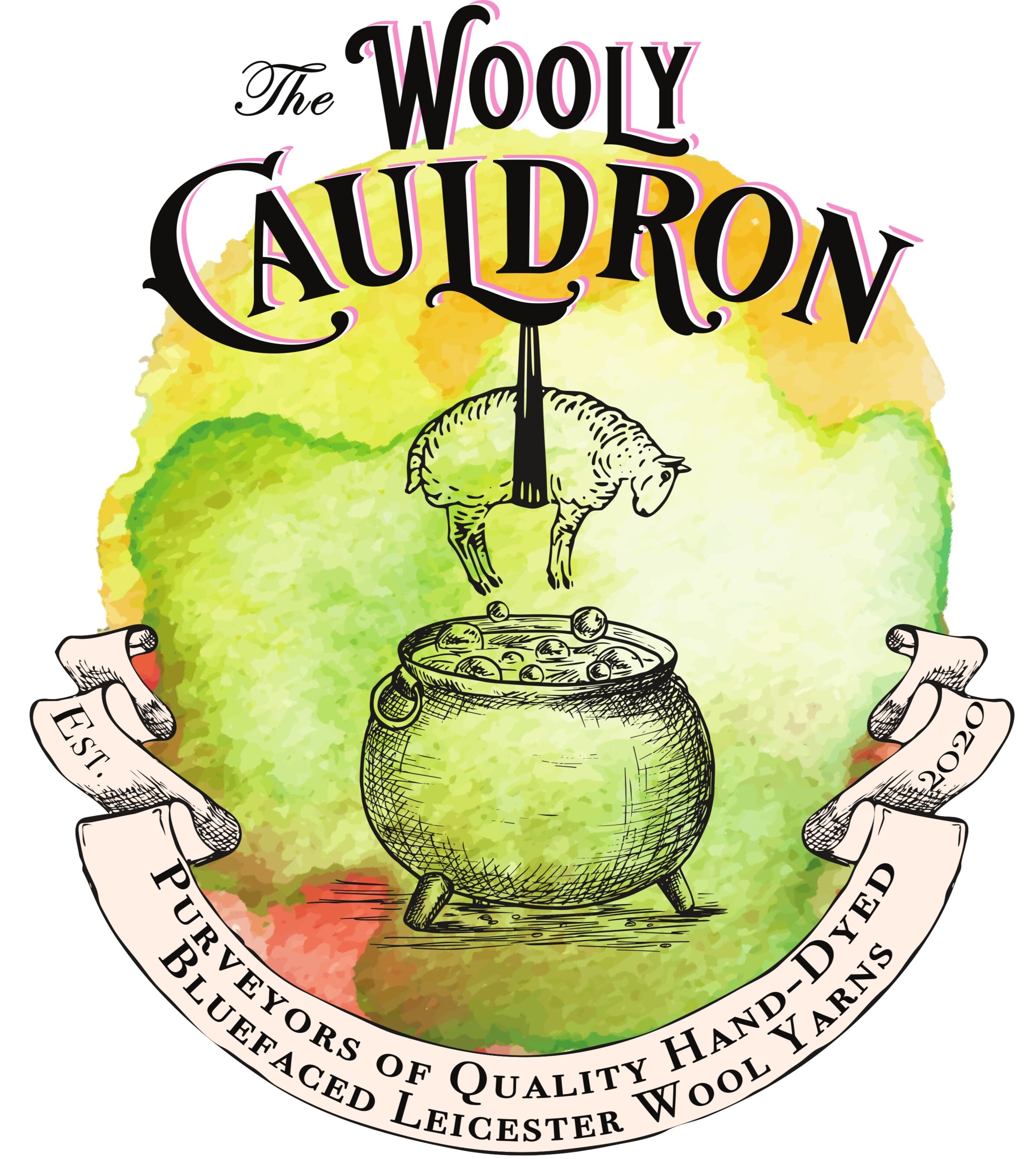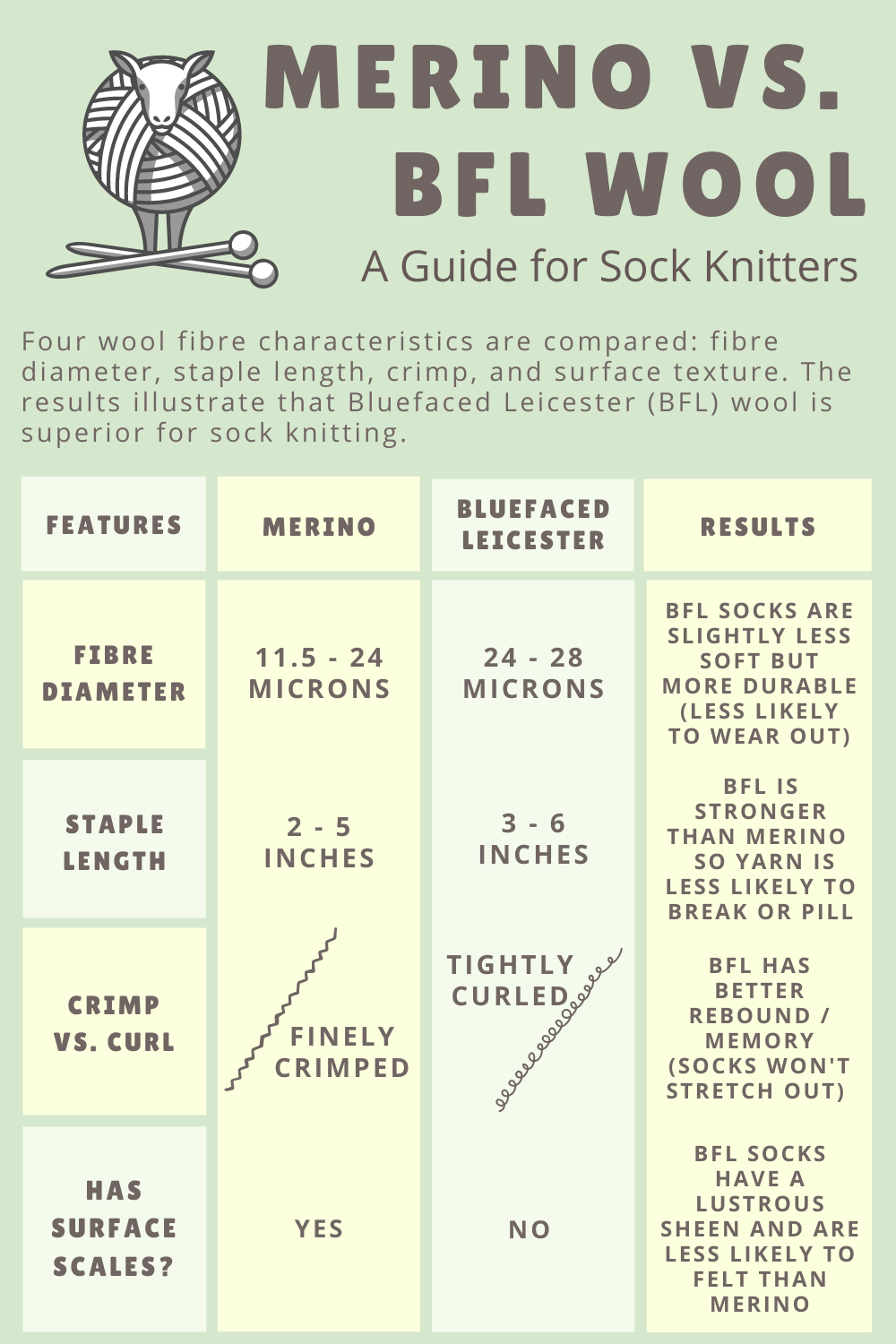Merino vs BFL Wool: A Guide for Sock Knitters
Merino vs BFL: A Guide for Sock Knitters
Merino sock yarn is everywhere so it must be the best, right?
In a word, no.
With the vast majority of indie dyed sock yarn being comprised of Merino/nylon blends, you might assume that these yarns are the best choice for socks. I used to think so, too, until I started to notice that a lot of my hand-knit Merino/nylon socks were felting, pilling, and stretching out of shape so badly that they constantly slipped down and off my ankles.
Socks that I’ve knit from other wool yarns, however, have held up way better than the Merino/nylons.
In my opinion, Bluefaced Leicester is the best yarn for sock knitting, hands down.
One of the first non-Merino yarns that I knit socks with was Bluefaced Leicester wool (BFL, for short), and I have since become fanatically loyal to this breed! So much so that I started my own business selling hand-dyed BFL wool yarn for sock knitters (check it out here)!
My BFL wool socks retain their shape really well, the ribbed cuff stays nice and grippy, and there is minimal felting and pilling compared to the Merino/nylon socks.
Yet Bluefaced Leicester is a relative newcomer to the knitting scene, and is definitely still the underdog when compared to Merino wool. So I thought it would be helpful to break down some of the inherent qualities of Merino vs BFL wool and explain why I think Bluefaced Leicester is the better yarn for sock knitting.
First of all, let’s quickly introduce the contenders.
Merino vs BFL: The Sheep and the Fibre
Bluefaced Leicester (pronounced LES-TER) is a specific breed of sheep with a characteristic ‘roman’ nose, giant bunny-like ears, and no wool on its head, neck, legs or belly. They are, frankly, super cute.
The term Merino, on the other hand, refers to a family of similar sheep breeds which all have very dense fleeces and produce finely crimped, soft to super-soft wool. Breeds in the Merino family include the Fonthill, Est-a-laine and Peppin Merinos, the Rambouillet, the Debouillet, and others!
Merino wool is by far the most common wool yarn sold by indie dyers and probably by your LYS (local yarn store), but it also has the most variability because of how many different kinds of sheep actually contribute their wool under name of ‘Merino’.
So what is it that makes Merino wool so popular among knitters and other yarn enthusiasts? In fact, the same qualities of Merino wool that make it so damn irresistible to us are also the qualities that make it a poor choice for sock knitting.
Softness
I believe that the primary reason for the popularity of Merino wool is its softness. We mere mortals can’t help but be drawn to things soft and squishy like Merino. But softness comes at the cost of strength and durability, as very fine fibres like Merino are more likely to break than coarser fibres like Bluefaced Leicester.
Here’s what you need to know about wool softness. I got much of this information from The Fleece and Fiber Sourcebook: More than 200 Spun Fibers, from Animal to Spun Yarn (Ecarius & Robson 2011), as well as from course material on Fibre Diameter, Staple Strength, Style, Handle and Curvature by Tony Schlink (2009).
The softness of wool is determined by how thick each wool fibre is, and this is measured in microns. Merino wool, being sourced from a number of different breeds of sheep, has an extremely wide range of fibre diameters: from about 11.5 microns to 25 microns! Ecarius & Robson claim that the average Merino fibre diameter is 20-22 microns.
The lower the micron count, the finer the wool fibre, and the softer the wool.
Merino wool varies from fine to ultra fine, but no matter where it lands on that scale it is generally soft enough to be worn against even sensitive skin.
Bluefaced Leicester wool, by comparison, is coarser than Merino, and averages 24-28 microns. It is therefore not as soft as Merino, but is still well below the threshold of being itchy or prickly to most people.
Drape
Another quality of Merino wool that knitters love is the drape of the knitted fabric. The drape of Merino is enhanced by the low micron count of Merino wool, and by the fibre’s very finely crimped texture. This crimp stretches out easily, but does not spring back so well!
Bluefaced Leicester wool, on the other hand, has a naturally curly or coiled structure, and this quality coupled with its greater micron count means that BFL wool yarn is both sturdier and springier than Merino. That’s a boon to sock knitters, because it means your socks are going to stay up while you’re wearing them and hold their shape when you wash them.
Surface texture and Lustre
Most wool types have surface scales on the outside of each fibre called cuticle scales. These scales grab onto each other and felt when exposed to moisture and friction (such as when your hot and sweaty feet rub inside your boots, for example).
Merino wool has these cuticle scales and consequently loves to felt! One of the most amazing qualities of BFL wool, however, is that it lacks these surface scales and is therefore naturally resistant to felting. It will still felt, but not as easily or as much as Merino. If you want to see a really amazing Bluefaced Leicester sheep felted from BFL wool, and read about the difficulties the artist had trying to get it to felt, click here!
The lack of surface scales on BFL wool also means that this fibre is more lustrous than Merino and takes dye gorgeously. Merino wool tends to be more flat and dull than Bluefaced Leicester wool, although I think it, too, dyes up beautifully.
Strength and durability
Unfortunately for Merino, its lower micron count means that it has less tensile strength than BFL wool, and is much more prone to breakage, wear, and pilling. Part of the reason why nylon or polyamide is added to Merino sock yarn is to account for this fragility.
Nylon and polyamide monofilaments (let’s just say nylon, for short) are petrochemical products which lend their strength and, to some extent, durability to the spun yarn. The most beneficial characteristic of nylon is its elasticity, so it not only resists breakage, but also can make the yarn springier.
Nylon does not prevent the individual wool fibres in your sock yarn from breaking or pilling – but rather, the nylon will simply hold the yarn together for longer. That is why you sometimes have Merino sock heels that ‘thin out’ – chances are, the nylon is still intact but most of the wool fibres have broken and pilled off.
So, you can see that nylon is beneficial to Merino wool sock yarn, specifically, because it supplements some of the durability, strength and springiness that Merino lacks. But that does not mean that you can’t knit socks without nylon!
Knitting socks with Bluefaced Leicester wool yarn
Unless you insist on using Merino wool yarn for knitting socks, you really don’t need any nylon in your yarn. My preference is to choose a yarn that is far better suited to knitting socks in the first place, like Bluefaced Leicester wool yarn.
Bluefaced Leicester wool has all of the natural qualities that you want in a sock yarn - strength, springiness, durability, and softness - without the need for any nylon.
BFL Sock Yarn does not require added nylon
If you’re still worried about durability, one thing you should always do is to knit your socks at a tighter gauge than is called for on the yarn tag. Personally, I always knit fingering weight sock yarn using my US size 1 knitting needles, sport weight with US size 2, and DK weight with size 3 or 4. This makes your sock fabric a bit denser and sturdier than it would be if you were to knit at the recommended gauge, as well as more resilient to rough and frequent wear.
I hope it doesn’t seem like I’m anti-Merino, because I’m not - I still have lots of it in my stash! I just think that it’s not particularly great for sock knitting and prefer to use it for things like tops, shawls, and scarves, where drape and softness become more important to the finished product than strength and durability.
If you have any questions about Merino vs BFL wool, feel free to ask! I love talking about my passion and hearing from other makers like you.
If you found this blog interesting or helpful, please sign up for The Wooly Cauldron Newsletter for more!
You’re welcome to pin or share this blog or the graphics herein as long as you credit @thewoolycauldron and link back to this page! Thank you for your support!



